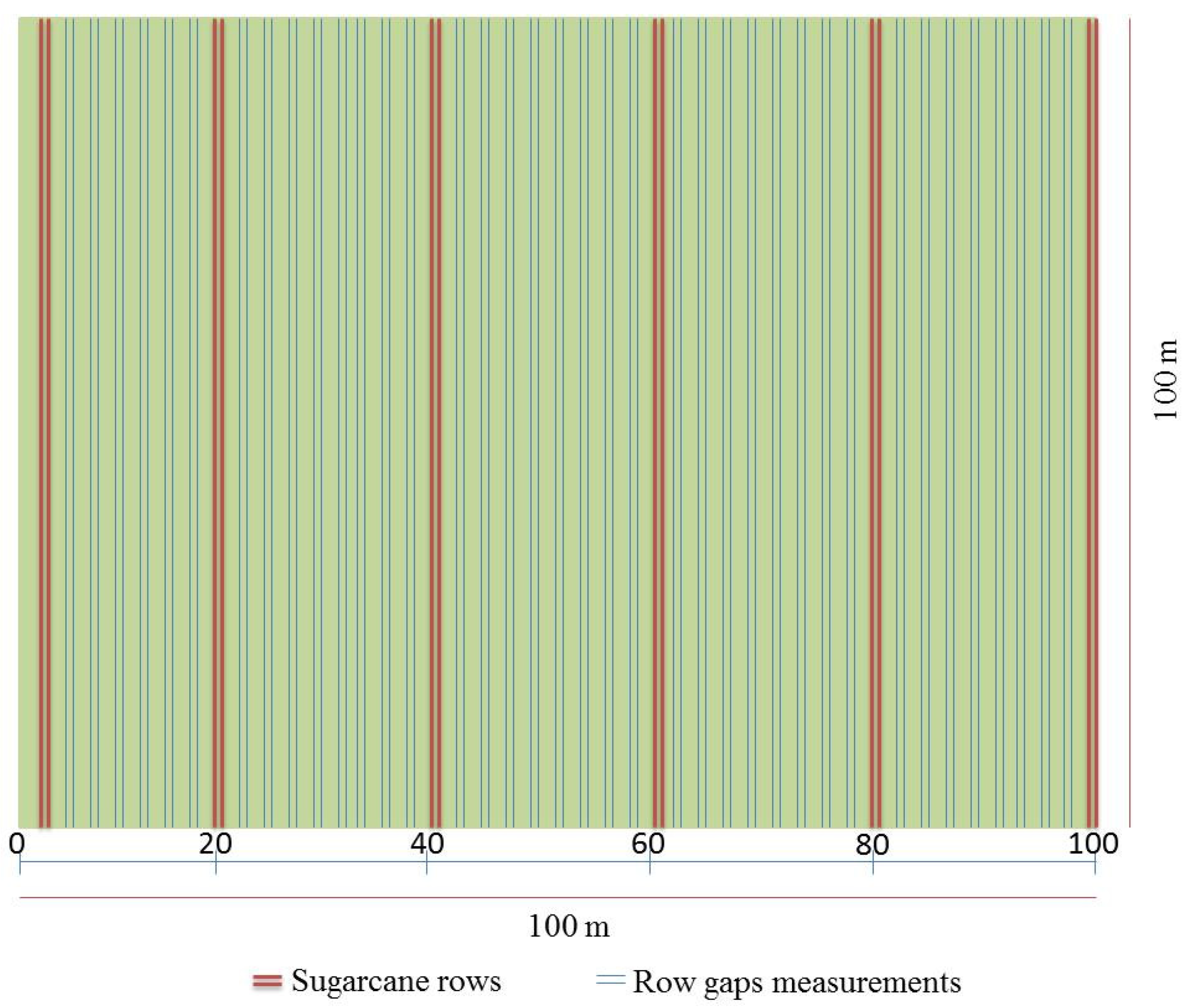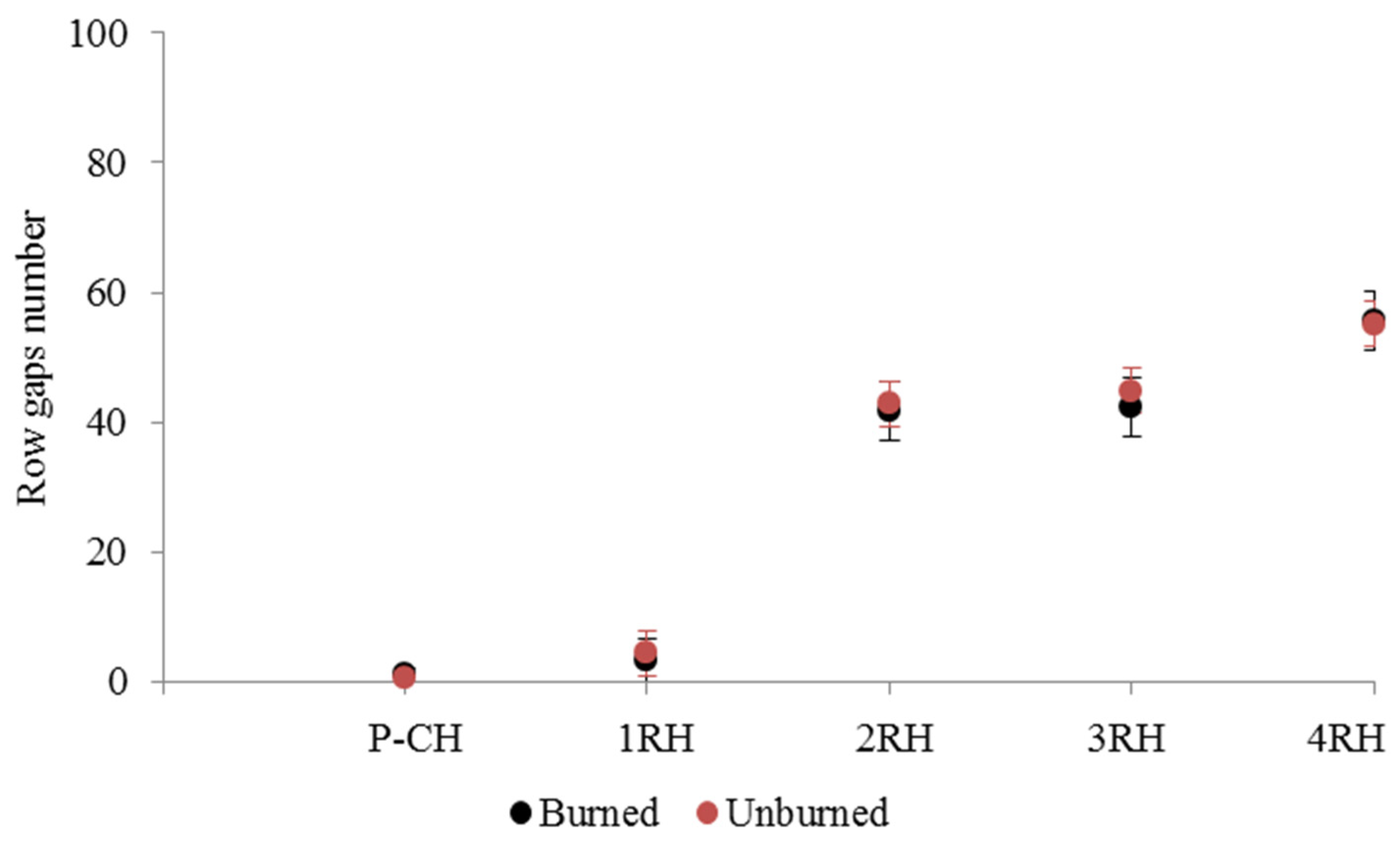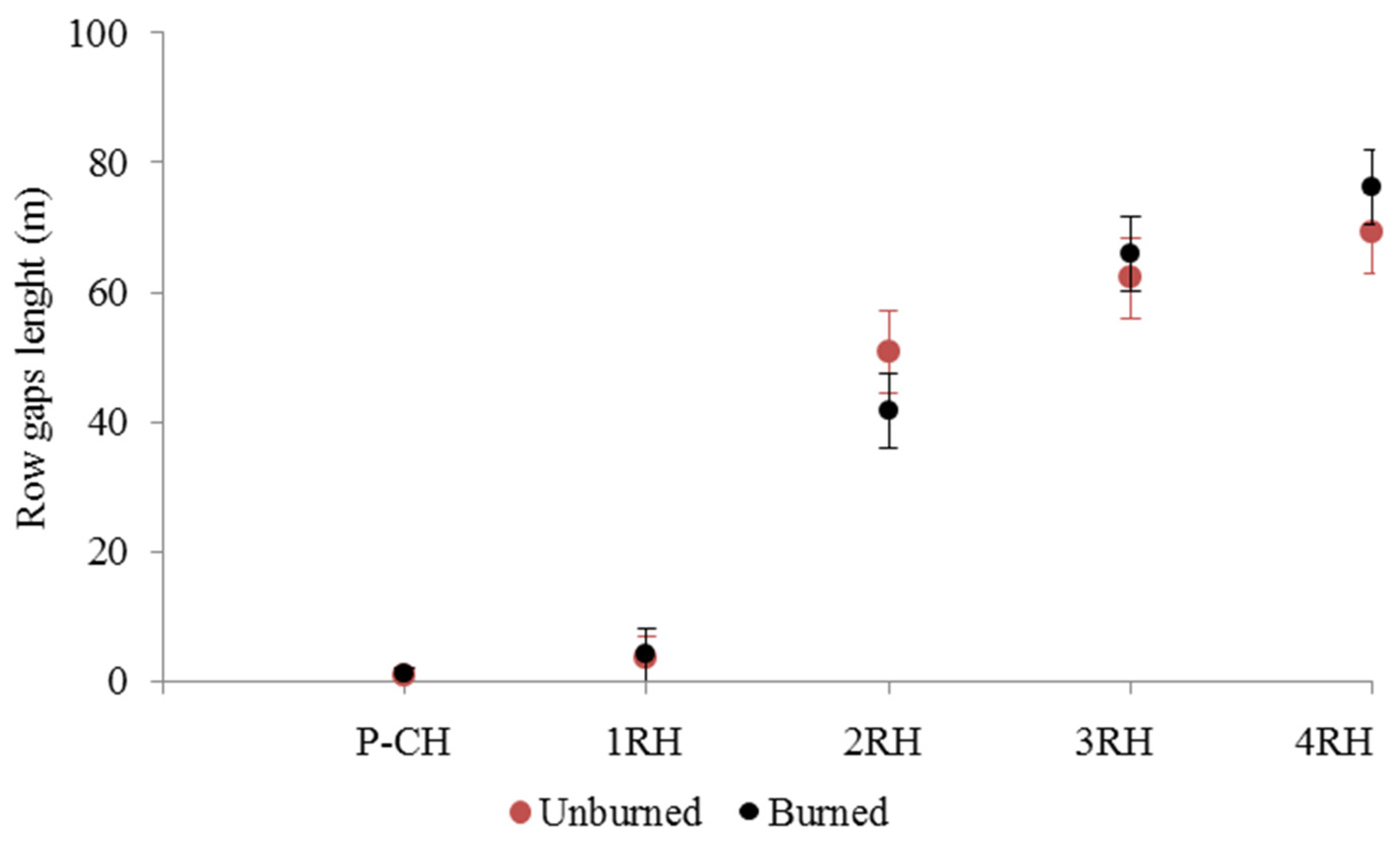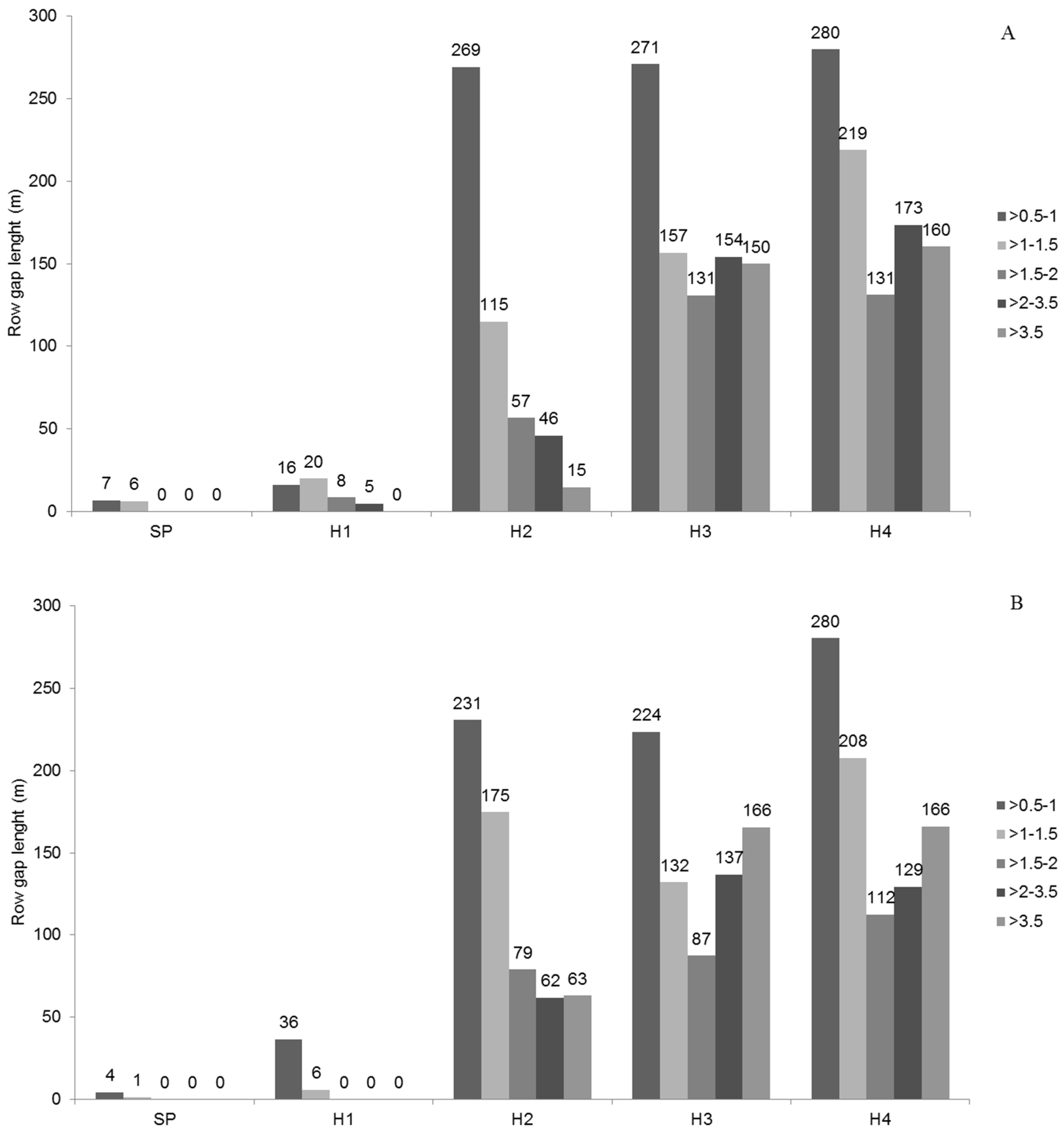Sugarcane Row Gaps Assessment over Successive Burned and Unburned Annual Harvests
Abstract
:1. Introduction
2. Materials and Methods
2.1. Study Site Characteristics
2.2. Measuring Sugarcane Row Gaps
2.3. Statistical Analysis
3. Results
3.1. Row Gap Number and Length
3.2. Row Gap Number and Length Classes
4. Discussion
4.1. Implications of Successive Sugarcane Harvests on the Emergence of Row Gaps
4.2. Implications of Increasing Row Gap Number and Length Classes
5. Conclusions
Author Contributions
Funding
Data Availability Statement
Conflicts of Interest
References
- FAO. FAOSTAT, Statistical Database; Food and Agriculture Organization: Rome, Italy, 2021. [Google Scholar]
- da Silva Gírio, L.A.; da Silva, R.P.; de Menezes, P.C.; Carneiro, F.M.; Zerbato, C.; Ormond, A.T.S. Quality of multi-row harvesting in sugarcane plantations established from pre-sprouted seedlings and billets. Ind. Crops Prod. 2019, 142, 111831. [Google Scholar] [CrossRef]
- Xie, L.; Wang, J.; Cheng, S.; Zeng, B.; Yang, Z. Performance evaluation of a chopper system for sugarcane harvester. Sugar Tech. 2019, 21, 825–837. [Google Scholar] [CrossRef]
- Companhia Nacional de Abastecimento-(CONAB); Acompanhamento de Safra Brasileira de Cana-de-Açúcar: Brasília, Brazil, 2023.
- de Almeida Silva, M.; Almeida de Holanda, L.; Pereira Sartori, M.M.; Germino, G.H.; de Moraes Barbosa, A.; Bianchi, L. Base cut quality and productivity of mechanically harvested sugarcane. Sugar Tech. 2020, 22, 284–290. [Google Scholar] [CrossRef]
- Jimenez, K.J.; Rolim, M.M.; Gomes, I.F.; de Lima, R.P.; Berrío, L.L.A.; Ortiz, P.F. Numerical analysis applied to the study of soil stress and compaction due to mechanised sugarcane harvest. Soil Tillage Res. 2021, 206, 104847. [Google Scholar] [CrossRef]
- Toledo, M.P.; Rolim, M.M.; de Lima, R.P.; Cavalcanti, R.Q.; Ortiz, P.F.; Cherubin, M.R. Strength, swelling and compressibility of unsaturated sugarcane soils. Soil Tillage Res. 2021, 212, 105072. [Google Scholar] [CrossRef]
- Lozano, N.; Rolim, M.M.; Oliveira, V.S.; Tavares, U.E.; Pedrosa, E.M.R. Evaluation of soil compaction by modeling field vehicle traffic with SoilFlex during sugarcane harvest. Soil Tillage Res. 2013, 129, 61–68. [Google Scholar] [CrossRef]
- Cavalcanti, R.Q.; Rolim, M.M.; De Lima, R.P.; Tavares, U.E.; Pedrosa, E.M.; Gomes, I.F. Soil physical and mechanical attributes in response to successive harvests under sugarcane cultivation in Northeastern Brazil. Soil Tillage Res. 2019, 189, 140–147. [Google Scholar] [CrossRef]
- Cavalcanti, R.Q.; Rolim, M.M.; de Lima, R.P.; Tavares, U.E.; Pedrosa, E.M.; Cherubin, M.R. Soil physical changes induced by sugarcane cultivation in the Atlantic Forest biome, northeastern Brazil. Geoderma 2020, 370, 114353. [Google Scholar] [CrossRef]
- Molin, J.P.; Veiga, J.P.S. Spatial variability of sugarcane row gaps: Measurement and mapping. Ciência Agrotecnologia 2016, 40, 347–355. [Google Scholar] [CrossRef]
- Rocha, B.M.; da Fonseca, A.U.; Pedrini, H.; Soares, F. Automatic detection and evaluation of sugarcane planting rows in aerial images. Inf. Process. Agric. 2022, 10, 400–415. [Google Scholar] [CrossRef]
- Santos, M.A.L.D.; Silva, S.; Zocoler, J.L.; Teodoro, I.; Dantas Neto, J.; Sousa, J.D.S. Avaliação de falhas na brotação da cana-de-açúcar em função da disponibilidade hídrica. Agropecu. Cient. no Semi-árido 2013, 9, 30–37. [Google Scholar]
- Bordonal, R.D.O.; Carvalho, J.L.N.; Lal, R.; de Figueiredo, E.B.; de Oliveira, B.G.; La Scala, N. Sustainability of sugarcane production in Brazil. A review. Agron. Sustain. Dev. 2018, 38, 13. [Google Scholar] [CrossRef]
- Rossetto, R.; Ramos, N.P.; de Matos Pires, R.C.; Xavier, M.A.; Cantarella, H.; Guimarães de Andrade Landell, M. Sustainability in sugarcane supply chain in Brazil: Issues and way forward. Sugar Tech. 2022, 24, 941–966. [Google Scholar] [CrossRef]
- Bernache, L.; Tedesco-Oliveira, D.; Oliveira, L.P.D.; Corrêa, L.N.; Silva, R.P.D. Can basal cutting blade wear affect sugarcane regrowth? Engen. Agrí. 2020, 40, 53–60. [Google Scholar] [CrossRef]
- Manhães, C.M.C.; Garcia, R.F.; Francelino, F.M.A.; de Oliveira Francelino, H.; Coelho, F.C. Fatores que afetam a brotação e o perfilhamento da cana-de-açúcar. Rev. Vértices 2015, 17, 163–181. [Google Scholar] [CrossRef]
- Alencastre-Miranda, M.; Davidson, J.R.; Johnson, R.M.; Waguespack, H.; Krebs, H.I. Robotics for sugarcane cultivation: Analysis of billet quality using computer vision. IEEE Robot. Autom. Lett. 2018, 3, 3828–3835. [Google Scholar] [CrossRef]
- Marques Filho, A.C.; Testa, J.V.; Moura, M.S.; Martins, M.B.; Lanças, K.P. Continuous and impact cutting systems for sugarcane harvester. Eng. Agrícola 2022, 42, e20210167. [Google Scholar] [CrossRef]
- Mello, R.D.C.; Harris, H. Desempenho de cortadores de base para colhedoras de cana-de-açúcar com lâminas serrilhadas e inclinadas. Rev. Bras. Eng. Agric. Ambient. 2003, 7, 355–358. [Google Scholar] [CrossRef]
- Corredo, L.D.P.; Canata, T.F.; Maldaner, L.F.; de Lima, J.D.J.A.; Molin, J.P. Sugarcane harvester for in-field data collection: State of the art, its applicability and future perspectives. Sugar Tech. 2021, 23, 1–14. [Google Scholar] [CrossRef]
- Matsuoka, S.; Stolf, R. Sugarcane Tillering and Ratooning: Key Factores for a Profitable Cropping. In Sugarcane: Production, Cultivation and Uses; Nova Publishers: Hauppauge, NY, USA, 2012; pp. 138–157. ISBN 9781612097459. [Google Scholar]
- Bocca, F.F.; Rodrigues, L.H.A.; Arraes, N.A.M. When do I want to know and why? Different demands on sugarcane yield predictions. Agric. Syst. 2015, 135, 48–56. [Google Scholar] [CrossRef]
- Maldaner, L.F.; Molin, J.P.; Martello, M.; Tavares, T.R.; Dias, F.L. Identification and measurement of gaps within sugarcane rows for site-specific management: Comparing different sensor-based approaches. Biosyst. Eng. 2021, 209, 64–73. [Google Scholar] [CrossRef]
- Soil Survey Staff. Available online: https://www.nrcs.usda.gov/sites/default/files/2022-09/The-Soil-Survey-Manual.pdf (accessed on 27 May 2023).
- Alvares, C.A.; Stape, J.L.; Sentelhas, P.C.; Gonçalves, J.D.M.; Sparovek, G. Köppen’s climate classification map for Brazil. Meteorol. Zeitschrift. 2013, 22, 711–728. [Google Scholar] [CrossRef] [PubMed]
- Stolf, R. Metodologia de avaliação de falhas nas linhas de cana-de-açúcar. Stab 1986, 4, 22–36. [Google Scholar]
- R Core Team. R: A Language and Environment for Statistical Computing 605; R Foundation for Statistical Computing: Vienna, Austria, 2021. Available online: http://www.Rproject.org (accessed on 15 April 2023).
- Li, X.; Wei, B.; Xu, X.; Zhou, J. Effect of deep vertical rotary tillage on soil properties and sugarcane biomass in rainfed dry-land regions of southern china. Sustainability 2020, 12, 10199. [Google Scholar] [CrossRef]
- Lampurlanés, J.; Angas, P.; Cantero-Martınez, C. Tillage effects on water storage during fallow, and on barley root growth and yield in two contrasting soils of the semi-arid Segarra region in Spain. Soil Tillage Res. 2002, 65, 207–220. [Google Scholar] [CrossRef]
- da Luz, F.B.; Castioni, G.A.F.; Tormena, C.A.; dos Santos Freitas, R.; Carvalho, J.L.N.; Cherubin, M.R. Soil tillage and machinery traffic influence soil water availability and air fluxes in sugarcane fields. Soil Tillage Res. 2022, 223, 105459. [Google Scholar] [CrossRef]
- Castioni, G.A.; de Lima, R.P.; Cherubin, M.R.; Bordonal, R.O.; Rolim, M.M.; Carvalho, J.L. Machinery traffic in sugarcane straw removal operation: Stress transmitted and soil compaction. Soil Tillage Res. 2021, 213, 105122. [Google Scholar] [CrossRef]
- Guimarães Júnnyor, W.D.S.; Diserens, E.; De Maria, I.C.; Araujo-Junior, C.F.; Farhate, C.V.V.; de Souza, Z.M. Prediction of soil stresses and compaction due to agricultural machines in sugarcane cultivation systems with and without crop rotation. Sci. Total Environ. 2019, 681, 424–434. [Google Scholar] [CrossRef]
- Ortiz, P.F.; Rolim, M.M.; de Lima, R.P.; Tormena, C.A.; Cavalcanti, R.Q.; Pedrosa, E.M. A soil physical assessment over three successive burned and unburned sugarcane annual harvests. Sugar Tech. 2023, 25, 518–530. [Google Scholar] [CrossRef]
- Manhães, C.M.C.; Garcia, R.F.; Junior, D.C.; Francelino, F.M.A.; de Oliveira Francelino, H.; dos Santos, C.M.F.G. Evaluation of visible losses and damage to the ratoon cane in the mechanized harvesting of sugarcane for different displacement speeds. Am. J. Plant Sci. 2014, 5, 2956–2964. [Google Scholar] [CrossRef]
- Silva, M.J.; Neves, O.L.D.; Correa, M.H.; de Souza, C.H. Quality indexes and performance in mechanized harvesting of sugarcane at a burnt cane and green cane. Sugar Tech. 2021, 23, 499–507. [Google Scholar] [CrossRef]
- Salvi, J.V.; Matos, M.A.; Milan, M. Avaliação do desempenho de dispositivo de corte de base de colhedora de cana-de-açúcar. Engen. Agrícola 2007, 27, 201–209. [Google Scholar] [CrossRef]
- Schossler, T.R.; Mantovanelli, B.C.; de Almeida, B.G.; Freire, F.J.; da Silva, M.M.; de Almeida, C.D.G.C.; Freire, M.B.G.D.S. Geospatial variation of physical attributes and sugarcane productivity in cohesive soils. Precis. Agric. 2019, 20, 1274–1291. [Google Scholar] [CrossRef]
- Gasparotto, L.G.; Rosa, J.M.; Grassini, P.; Marin, F.R. Developing an operational framework to diagnose yield gaps in commercial sugarcane mills. Field Crops Res. 2022, 278, 108433. [Google Scholar] [CrossRef]
- Momin, M.A.; Wempe, P.A.; Grift, T.E.; Hansen, A.C. Effects of four base cutter blade designs on sugarcane stem cut quality. Trans. ASABE 2017, 60, 1551–1560. [Google Scholar] [CrossRef]
- Ripoli, T.C.C.; Ripoli, M.L.C. Stalk Harvesting Systems. In Sugarcane; Academic Press: Cambridge, MA, USA, 2015; pp. 205–239. [Google Scholar] [CrossRef]






| Characterization | Sugarcane Areas | |
|---|---|---|
| Soil class | Ultisol | |
| Particle density (g cm−3) | 2.63 | |
| Layer (m) | 0–0.20 | 0.20–0.40 |
| Soil texture | Sandy loam | Sandy loam |
| Sand (%) | 83 | 79 |
| Silt (%) | 9 | 9 |
| Clay (%) | 8 | 12 |
| Organic carbon (g kg−1) | 17.0 | 12.0 |
| Bulk density (g cm−3) | 1.65 | 1.71 |
| Cultivation Stages | Characterization |
|---|---|
| P-CH | The areas underwent conventional tillage, and after preparation, the planting of sugarcane was carried out using 12 tons of sugarcane stems per hectare (15/02/2018) |
| 1RH | Experimental period after plant-cane harvest. The occurrence of one harvest (27/12/2018—unburned area, 16/01/2019—burned area) |
| 2RH | Experimental period after the first crop. The occurrence of two harvests (28/12/2019—unburned area, 20/01/2020—burned area) |
| 3RH | Experimental period second ratoon harvest. The occurrence of three harvests (15/12/2020—unburned area, 28/01/2021—burned area) |
| 4RH | Experimental period after third ratoon harvest. The occurrence of four harvests (15/02/2022—unburned area, 20/02/2022—burned area) |
Disclaimer/Publisher’s Note: The statements, opinions and data contained in all publications are solely those of the individual author(s) and contributor(s) and not of MDPI and/or the editor(s). MDPI and/or the editor(s) disclaim responsibility for any injury to people or property resulting from any ideas, methods, instructions or products referred to in the content. |
© 2023 by the authors. Licensee MDPI, Basel, Switzerland. This article is an open access article distributed under the terms and conditions of the Creative Commons Attribution (CC BY) license (https://creativecommons.org/licenses/by/4.0/).
Share and Cite
Cavalcanti, R.Q.; Rolim, M.M.; de Lima, R.P.; Ortiz, P.F.S.; Pedrosa, E.M.R.; de Moraes Rodrigues, J.A. Sugarcane Row Gaps Assessment over Successive Burned and Unburned Annual Harvests. Agronomy 2023, 13, 2545. https://doi.org/10.3390/agronomy13102545
Cavalcanti RQ, Rolim MM, de Lima RP, Ortiz PFS, Pedrosa EMR, de Moraes Rodrigues JA. Sugarcane Row Gaps Assessment over Successive Burned and Unburned Annual Harvests. Agronomy. 2023; 13(10):2545. https://doi.org/10.3390/agronomy13102545
Chicago/Turabian StyleCavalcanti, Roberta Q., Mário M. Rolim, Renato P. de Lima, Pedro F. S. Ortiz, Elvira M. R. Pedrosa, and Joez A. de Moraes Rodrigues. 2023. "Sugarcane Row Gaps Assessment over Successive Burned and Unburned Annual Harvests" Agronomy 13, no. 10: 2545. https://doi.org/10.3390/agronomy13102545





